- Get link
- X
- Other Apps
Top 40 Test Automation Interview Questions You Need To Know
Testing is crucial to the success of any software product. The prime objective of software testing is to get a high-quality output while reducing the cost and the time required to complete the project. But testing to find defects or bugs manually is time-consuming, expensive, often repetitive, and subject to human error. This is where automation comes into the picture. The Automation Testing Course is the perfect guide for learning how to be a Test Automation Engineer.
Test Automation or Automation Testing uses the assistance of tools, scripts, and software to perform test cases by repeating pre-defined actions. Automating software testing will give companies a competitive edge in the market.
With the adoption of automation becoming increasingly widespread, software testers with manual testing skills alone won’t be able to make it in today’s job market. If you are preparing for an Automation Testing job interview, you must be aware of the most frequently asked questions in the test automation field. With that in mind, in this article on Test Automation Interview Questions, I will discuss the top questions about automation testing in the interviews. For your better understanding, I have divided the Automation Testing interview questions into the following sections:
- Beginners Level Test Automation Interview Questions
- Intermediate Level Test Automation Interview Questions
- Advanced Level Test Automation Interview Questions
Beginners Level Test Automation Interview Questions
Test Automation Interview Questions section will cover all the basic questions you need to know about Automation Testing.
Q1. What is Automation Testing?
 Automation replaces manual human activity with systems or devices that enhance efficiency. Automation Testing uses various software tools or scripts to perform testing tasks such as entering data, executing test steps, comparing results, etc.
Automation replaces manual human activity with systems or devices that enhance efficiency. Automation Testing uses various software tools or scripts to perform testing tasks such as entering data, executing test steps, comparing results, etc.
Q2. What are the different types of Automation Testing?
Different types of test automation are unit tests, GUI tests, and functional tests.
- Unit tests are usually done during the development phase to reduce the bugs.
- GUI tests are done at the testing level, where tests are scripted to test how the user interface of an application behaves.
Functional tests are also done at the testing level to simulate the functional scenarios to test the application with provided input and for expected output.
Q3. What is an automated test script?
An automated test script is a short program written in a programming language to perform a set of instructions on an application. This is done to verify if the application is as per the requirements or not. When you run the script, it gives the test results as pass or fails based on whether the application is working as per the expectations.
Q4. What should good coding practices be followed while writing test cases for automation?
Certain good practices that you should follow when writing test cases are:
- Use comments at the appropriate places
- Maintain separate files for reusable functions
- Follow coding conventions
- Run scripts regularly
Q5. What is a Test Automation Framework?
A test automation framework is a set of universal guidelines and rules used to produce beneficial results for test automation activity. The automation framework combines function libraries, test data sources, object details, and other reusable modules and methods. The automation framework makes testing consistent. Some of the guidelines are as follows:
- Rules for writing test cases
- Coding guidelines for creating test scripts
- Input test data templates
- Object repository management
- Log configuration
- Test result and reporting usage
Q6. Why use automation frameworks? What are the benefits that they offer?
Using an automation framework avails a lot of benefits like:
- The framework enables consistency in testing. It provides a universal standard for testers to achieve the specific goals of their automated tests.
- When designed and implemented correctly, automation frameworks deliver frequent and stable automated test code.
- With a proper framework, the code is easier to maintain and reuse
- Even with limited knowledge of how the test case is set up, a tester can depend on the framework to refer to simple statements and easily implement the test cases.
Q7. What are the different types of automation frameworks that are available?
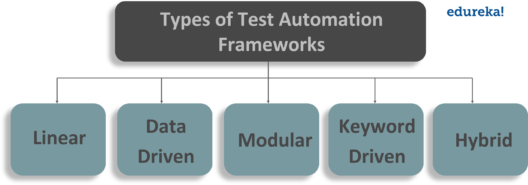
Linear Scripting Framework: It is a basic level test automation framework in the form of ‘Record and Playback’ but in a linear fashion. This type of framework is mostly used to test small-sized applications.
Data-Driven Framework: It creates test automation scripts by passing different test data sets. The test data, which includes input, expected output, and a result field, are stored in CSV files, excel files, text files, XML files, etc.
Modular Testing Framework: Here, the testers divide the application into multiple small modules and create test scripts individually. These individual test scripts are combined to make larger test scripts using a master script to achieve the required scenarios.
Keyword Driven Framework: In this framework, testers use a table format to define keywords or action words for each method. Based on the keywords specified in the excel sheet test, scripting is done, and tests are executed.
Hybrid Testing Framework: As the name suggests, this framework is the combination of two or more frameworks mentioned above. It attempts to leverage the strengths and benefits of other frameworks based on the tester’s requirements.
Q8. What are the prerequisites to start automation testing?

- Framework build should always be stable
- Use reusable functions and procedures
- Store reusable functions in separate files
- Filter & segregate the test cases to be automated
- Make sure modules don’t change frequently
- Employ skilled and experienced resources
Q9. What are the factors that determine the effectiveness of Automation Testing?
The factors that determine the success of automation are:
- Time saved
- Number of defects found
- Test coverage
- Maintenance Time
- Installment cost
- Test re-usability
- Quality of software under test
Q10. What are the main differences between Automation Testing & Manual Testing?
| Manual Testing | Automation Testing |
| In manual testing, the accuracy and reliability of test cases are low, as manual tests are more prone to human error. | On the other hand, automated testing is more reliable as tools and scripts are used to perform tests. |
| The time required for manual testing is high as human resources perform all the tasks. | The time required is comparatively low as software tools execute the tests |
| In manual testing, the investment cost is low, but Return of Investment(ROI) is also low. | In automation testing, investment cost and Return on Investment are both high. |
| Manual testing is preferred when the test cases are run once or twice. Also suitable for Exploratory, Usability, and Adhoc Testing. | You can use test automation for Regression Testing, Performance Testing, Load Testing, or highly repeatable functional test cases. |
| Allows for human observation to find out any glitches. Therefore manual testing helps in improving the customer experience. | As no human observation is involved, there is no guarantee of a positive customer experience. |
Q11. Is it possible to achieve 100% automation?
100% automation is not achievable. Because there are certain test cases that cannot easily be automated, in such cases, writing automation tests will take far more effort than it would ever save. For example, checking the background color of a window or dialog box. Creating a test case for such a simple task would take double the time and effort. Manual testing is best in such cases. So, complete automation is not possible.
Q12. What are some conditions where we cannot consider automation testing?
- When you have ever-changing requirements
- Exhaustive documentation
- One-time test cases
- Ad-hoc testing
- Exploratory testing
- User interface testing
Q13. What are some modern applications of Automation Testing?

Selenium Certification Training Course
- Instructor-led Sessions
- Assessments
- Assignments
- Lifetime Access

Well, there are a plethora of examples that I can list. Here are a few interesting ones. Amazon is testing delivery drones that pick up warehouse orders sorted by robots. Google is testing self-driving cars. While Starbucks is testing cashier-free stores dedicated to mobile ordering and payment. Facebook is testing a brain-computer interface that may one day translate thoughts into digital text.
Q14. Can automation testing replace manual testing?
Automation testing isn’t a replacement for manual testing. No matter how good automated tests are, you cannot automate everything. Manual tests play an important role in software development and come in handy whenever you have a case where you cannot use automation. Automated and manual testing each has its own strengths and weaknesses. Manual testing helps us understand the entire problem and more flexibly explore other angles of tests. On the other hand, automated testing helps save time in the long run by accomplishing a large number of surface-level tests in a short time.
Q15. Is documentation necessary in Automation Testing?

Documentation plays a very important role in Test Automation. All the methods and procedures you employ should be documented to be repeatable. Test specifications, designs, configurations, code changes, automation plans, test cases listed for automation, bug reports, and user manuals should all be documented.
Q16. Name some popular Automation Testing tools used worldwide.
Some of the most popular automation testing tools include Selenium, Watir, Ranorex, Appium, UFT, Tosca, and SoapUI.
Intermediate Level Test Automation Interview Questions
This section of Test Automation Interview Questions will cover the topics like why automate, how to automate, and automation testing tool selection.
Q17. When should you prefer Manual Testing over Automation Testing?
There are certain cases where manual testing is preferred over automation testing, like:
- Short-time projects: Though automated tests aim to save time and resources, designing and maintaining them takes time and resources. For example, if you are building a small promotional website, it can be much more efficient to rely on manual testing.
Ad-hoc Testing: In ad-hoc testing, there is no specific approach. It is a totally unplanned testing method where the tester’s understanding and insight is the only important factor.
Exploratory Test: This testing requires the tester’s knowledge, experience, analytical, logical skills, creativity, and intuition. So human involvement is important in exploratory testing.
- Usability Testing: Here, the tester needs to measure how user-friendly, efficient, or convenient the software or product is for the end users. Human observation is the most important factor, so a manual approach is preferable.
Q18. When is Automation testing useful? Which test cases to Automate?
It is impossible to automate all test cases, so it is important to determine which ones to be automated first. There are some top candidates like:
- Repetitive tasks are primary candidates. Not only are those tasks boring, but they’re often the ones where mistakes are most common.
- Tests that require multiple data sets. Rather than manually typing all the information into fields, automate the process to read information from a data source and automatically type it into the respective forms.
- Tests run on several different hardware or software platforms and configurations.
- Manually exporting the bulk of data, crunching the numbers, and making detailed graphs is time-consuming. You can invest in a tool or automation strategy to do your task.
Q19. How to implement automation? What would be the steps?
Success in test automation requires careful planning and design work. The steps include:
- First, you should define your goal for automated testing and determine which types of tests to automate. Once you are sure of what kind of test you are performing, you need to select the appropriate tool.
- Next, you define the scope of automation. Decide which test cases to automate.
- After determining your goal and which types of tests to automate, you should decide what actions your automated tests will perform. Create test scripts and develop test suits to hold your test cases.
- The next step is execution. Execution can be performed using the automation tool directly or through the Test Management tool, which will invoke the automation tool.
- Once executed, the next step is to create report formats so that individual test logs with detailed actions performed during testing are recorded. Define the type of test report format to be created, screenshots, messages, etc.
Q20. What are the different approaches to Test Automation?
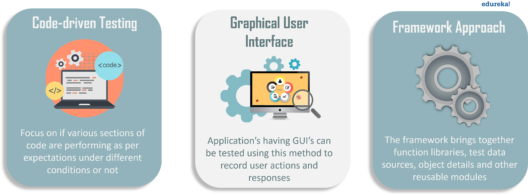
Code-Driven Testing: Here, the focus is mainly on test case execution to determine whether the various sections of code are performing as per expectations. This testing approach is a popular method used in agile software development.
Graphical User Interface (GUI) Testing: This approach may test applications with GUIs. Testers can record user actions and analyze them any number of times. Test cases can be written in several programming languages like C#, Java, Perl, Python etc.
Test Automation Framework: Framework is a set of guidelines used to produce beneficial results of automated testing activity. It combines function libraries, test data sources, object details, and other reusable modules.
Q21. What are the points that are covered while the planning the phase of automation?
- Decide the right automation tool
- Choose the right automation framework if needed
- Define the scope of automation
- Plan for test cases & test suites
- Identify test deliverables
- Set up test environment configurations
Q22. How to decide which tool to use for Automation testing in the projects?
To decide which tools to choose, you can follow the steps listed below:
- Understand your project requirements thoroughly and identify the testing scenarios that you want to automate
- Search for the list of tools that suit your project’s requirements
- Identify your budget for the automation tool
- Now compare each tool for key criteria: is it easy to develop and maintain the scripts for the tool or not, does it work on platforms like web, mobile, desktop, etc? Does the tool have a test reporting functionality? How many testing types can this tool support? How many languages does the tool support?
- Once you have compared the tools, select the tool within your budget. Make sure it gives you more advantages based on the above key criteria.
Q23. What are the primary features of a good automation tool?
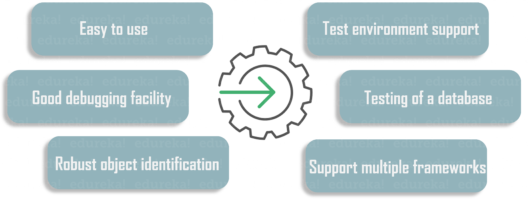
Q24. On what basis can you map the success of automation?
- Defect Detection Ratio
- Automation Execution Time
- Reduce in the labor cost
Q25. What is the scripting standard while performing automation testing?
Uniformity in naming convention, commenting on the functionality whenever and wherever necessary, adequate indentation, robust error handling, and the ability to recover easily are some good practices you should follow while scripting.
Q26. What are the differences between open source tools, vendor tools & in-house tools in automation testing?
Software Testing Training
- Open Source Tools: Free tools with source code available on the internet
- Vendor Tools: These tools are developed by companies, and they come with licenses
- In-House Tools: Tools built by companies for their own use
Q27. What are the advantages of using an Automation Framework?
The advantages of using a test automation framework are:
- Re-usability of code
- Reliable recovery scenarios
- Maximum test coverage
- Low maintenance cost
- High Return of Investment(ROI) in the long run
- Minimal manual intervention
- Easy reporting capabilities
Q28. What are the important modules of the Test Automation Framework?
Test Assertion Tool: This module will provide assert statements for testing the expected values in the application under test.
Data Setup: Each test case needs to take the user data from the database, a file, or embedded in the test script.
Build Management Tool: Tool that you can use to build a framework so that you can create test scripts.
Continuous integration tool: Continuous Integration/Continuous Delivery tools are required for integrating and deploying the changes done in the framework at each iteration.
Reporting tool: A reporting tool is required to generate a readable report after the test cases are executed. This way, you can better view the steps, results, and failures.
Logging tool: The tool in the framework helps better debug errors and bugs.
Q29. What are some popular automation testing frameworks available?

Q30. What are the use cases where implementing automation is not suggested?
100% test automation is impossible. Manual testing is still necessary. Tests that cannot be automated are:
- Ad hoc testing – This is done without preparing and writing test cases. During ad hoc testing, a QA specialist randomly tests the system’s functionality; his aim is to be creative, “break” the system and discover flaws.
- Exploratory testing – During exploratory testing, a QA specialist tests a product like an explorer, relying on his personal experience. After getting the idea of a product’s functionality, a tester designs test cases that he uses to further test the product. In exploratory testing, the tester needs to rely on his personal experience and design test cases in the testing process.
- User interface testing – Here, a QA specialist validates the properties and states of interface elements. Also, they ensure that the interface design elements match elements in the final layout.
Advanced Level Test Automation Interview Questions
Test Automation Interview Questions section will cover tricky questions related to automation testing.
Q31. What are the advantages & disadvantages of using Automation Testing?
Advantages of automation testing are:
- Improves the reliability of tests
- Reduces maintenance cost
- Increases amount of test coverage
- Increases the speed of test execution
- Improves accuracy of the software tests
Disadvantages of automation testing include:
- Development and maintenance time is more
- The initial investment is high
- Skilled resources are required
- Environment set up is complex
- Debugging test scripts is difficult
Q32. Is Automation Testing a Black-box testing or a White box testing?
Automated testing can be both black or white box type of testing depending on the scenarios in which automation is performed. It is black box testing as a tester usually tests the application without knowing its low-level design or code. But sometimes, automated test scripts need access to the database details that are used in the application. Thus, it can be a type of white-box testing as well.
Q33. What are the attributes of a good Test Automation Framework?
- Modular: The framework should be adaptable to change.
- Reusable – The commonly used methods or utilities should be kept in a file easily accessible to all the scripts.
- Consistent – The test suite should be written consistently by following the coding practices.
- Independent – The test scripts should be written to be independent of each other.
- Logging – It is good to implement the framework’s logging feature.
- Reporting – Once the scripting is done, we can have the results and reports sent via email.
- Integration – The automation framework should be such that it is easy to integrate with other applications.
Q34. What are Test Automation Framework development challenges?
Some of the challenges that you come across while using frameworks are:
- Ability to understand what needs to be achieved out of test automation
- Identifying requirements from multiple areas to design automation Framework
- Tool identification
Q35. What is data-driven testing?
The aim of data-driven automation testing is to simplify the testing process involving complex and huge data sets. In Data Driven Testing, the test data includes input, expected output, and a result field. These fields are listed in CSV files, excel files, text files, XML files, etc. These files are then fed to the automation tool for execution, which compares the expected and actual data. Then the obtained results are documented in the result field.
Q36. What is TestNG? List out some of its prominent features.
TestNG is an open-source automated testing framework, where NG refers to NextGeneration.The creator of TestNG is Cedric Beust. It is inspired by other frameworks like JUnit and NUnit. It is designed to be better than JUnit, especially while testing integrated classes.TestNG allows the developer to write more flexible and powerful tests with ease. Some of its prominent features include:
- Supports annotations
- Based on more Java and OO features
- Supports testing integrated classes
- Provides flexible runtime configuration
- Supports dependent test methods, parallel testing, and load testing
- Offers flexible plug-in API.
- And supports multithreading as well.
Q37. What are the advantages of TestNG over JUnit?
In TestNG, testing is based on Junit, but it is designed to overcome the limitations of JUnit. Some advantages of TestNG over Junit are:
- Annotations are easier to understand in TestNG
- In TestNG, test cases can be grouped easily
- TestNG supports parallel testing, unlike in JUnit
Q38. In what conditions can we not use the Automation Testing for the Agile method?
Test teams responsible for product development at companies adopt Agile practices to achieve their goals. Test automation is a fundamental part of Agile, but there are certain times when automation testing in agile is useless, like:
- When there is an exhaustive level of documentation
- When the requirements keep changing
- One-time tasks and exploratory testing cases shouldn’t be automated
Q39. What are some best practices that you should follow during Automation Testing?

Selenium Certification Training Course
Weekday / Weekend BatchesTo get maximum ROI of automation, keep track of the following points:
- The scope of Automation needs to be determined in detail before the start of the project
- Select the right automation tool that fits your requirements
- Choose an appropriate framework if needed
- Follow scripting standards while writing the scripts for automation
- Next, check if the automation that you performed is successful or not. Measure metrics like
- Percent of defects found
- The time is taken for automation
- Customer Satisfaction Index
- Productivity improvement
Q40. What are the risks associated with test automation?
Some of the risks involved with automation testing are:
- It demands skilled resources with some knowledge about programming and the ability to adapt easily to the new technologies
- The initial cost of automation is too high
- If the user interface has ever-changing requirements, then automation testing will be problematic
- If the application that is being tested is not stable, you might encounter a lot of errors.
Well, that’s it! We have reached the end of the Test Automation Interview Questions Article.
I hope the questions listed in this “Automation Testing Interview Questions” help you crack your interview. Happy learning!
If you found this “Test Automation Interview Questions” article relevant, check out the Automation Testing Training in Bangalore by Edureka, a trusted online learning company with a network of more than 250,000 satisfied learners spread across the globe.
Got a question for us? Please mention it in the comments section on this “Test Automation Interview Questions and Answers” and we will get back to you.
| Course Name | Date | |
|---|---|---|
| Selenium Certification Training Course | Class Starts on 10th September,2022 SAT&SUN (Weekend Batch) | View Details |
| Selenium Certification Training Course | Class Starts on 19th September,2022 MON-FRI (Weekday Batch) | View Details |
| Selenium Certification Training Course | Class Starts on 8th October,2022 SAT&SUN (Weekend Batch) | View Details |
Recommended videos for you
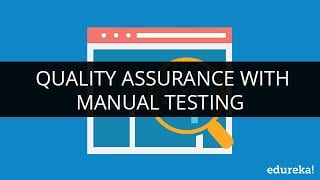
Quality Assurance With Manual Testing
Watch Now
Automate Web Apps Testing With Selenium Webdriver
Watch Now
Selenium Tutorial – A Complete Tutorial on Selenium Automation Testing
Watch Now
Top 30 Selenium Interview Questions And Answers
Watch Now
Test Automation With Selenium Webdriver
Watch Now
Why Use Selenium with $3 Million Bugs?
Watch Now
Selenium IDE Tutorial – Get Started With Selenium IDE
Watch Now
Automated Testing Using Selenium Webdriver
Watch Now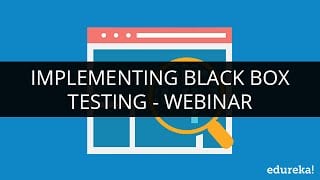
Implementing Blackbox Testing
Watch Now
Selenium Grid Tutorial – Get Started With Selenium Grid
Watch Now
Selenium WebDriver Tutorial – Get Started With Selenium WebDriver
Watch NowRecommended blogs for you

What is Agile Testing? Know about Methods, Advantages and Principles
Read Article
What is API Testing? A Simple Guide on How to Perform API Testing
Read Article

Comments
Post a Comment